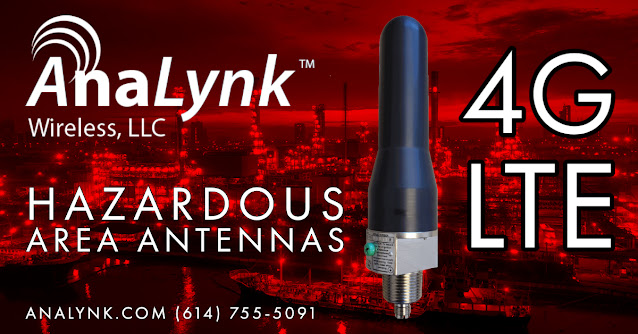Analynk Wireless manufactures hazardous area wireless access point enclosures and hazardous area wireless antennas. Analynk is also a certified UL508A panel manufacturer providing high quality control panels to Ohio and surrounding areas. For more information, visit the Analynk website here or call 614-755-5091.
The Analynk AP431 Dual-Band Hazardous Area Enclosure for the Cisco C9115AXE Access Point
- Pharmaceuticals
- Oil refineries
- Oil & Gas Platforms
- Chemical Plants
- AP431
- AP431-ATEX
- AP431-N4 (NEMA 4X rating)
CTX/CTM Series Hazardous Area 4G LTE Explosion Proof Antennas
The Analynk CTX/CTM 4G LTE antennas are designed for use in “Hazardous-Classified” and Industrial-Hardened applications. The antennas are omnidirectional, with an average gain of 1.27dBi with a peak gain of 2.46 dBi. Two antenna versions are available, the CTX series has a 3/4” NPT mount, and the CTM series has an M20 mount. The antennas can be mounted on an Explosion Proof enclosure or conduit. The mounting base is made of heavy nickel-plated brass with an integrated TNC-F connector for ease of installation. The radome is optimized for rugged industrial applications while maintaining maximum radio frequency transmission and reception efficiency. The antennas have a built in Explosion Proof seal and may be mounted up to 18” away from the enclosure without an additional seal.
Get more information and download a specification sheet here.
Analynk Wireless
(614) 755-5091
Analynk AP420 Explosion Proof Access Point Enclosure For Meraki/Cisco MR42E
The AP420 is a hazardous area enclosure designed to house the Meraki/Cisco MR42E dual band access point.The enclosure and antennas are rated for Class I, Div 1, groups C & D Hazardous Locations. All hardware, mounting plate, and RF cables are provided to make installation of the access point quick and easy. The enclosure includes five hazardous area 2.4GHz/5GHz antennas, the MR42E is not included.
Ratings: Class I, Div 1 Groups, C & D, ATEX Zone 1 optional
Applications:
- Pharmaceuticals
- Oil refineries
- Oil & Gas Platforms
- Chemical Plants
Ordering information:
- AP420
- AP420-N4 (NEMA 4 rating)
- AP420-ATEX
For more information call Analynk at 614-755-5091 or visit this web page.
Industrial Wireless Networking Considerations
Implementation of complex monitoring and control processes by industrial automation systems in the chemical industries, power plants, oil refineries, and water delivery systems are typical. The industrial networks for process automation at these sites typically encompass broad areas, with highly dense networks with hundreds or thousands of nodes.
The harsh industrial environment presents several obstacles for wireless communications, the most significant of which are dependability, fault-tolerance, and low latency. Unpredictable changes in temperature, humidity, vibrations, and pressure and the presence of highly reflective (metal) items and electromagnetic noise make industrial surroundings stressful.
In these installations, thousands of devices provide measured values (such as temperature, pressure, flow, and location) to actuators that control processes and servers that coordinate the manufacturing steps. Wiring is often tricky and expensive, particularly in combustible and explosive areas (for example, in the presence of flammable gases in an oil refinery.) Remote or inaccessible places are difficult to reach, and mobile nodes can only be connected intermittently. Even though the amount of data is relatively low in an industrial application, dependability and latency are crucial, and complete data delivery in real-time is a must.
Key constraints that hinder the actual deployment of wireless networks in such settings are battery capacity and device power consumption. Communication and power wires, ideally, can be eliminated to provide a completely wireless system. To that end, the devices should be energy efficient and capable of running for years on a single charge from a battery. Furthermore, wireless networks bring logical benefits to maintenance and commissioning, such as "plug-and-play" automation systems to reduce downtime and speed up tests, as well as "hot-swapping" malfunctioning modules.






